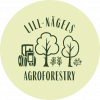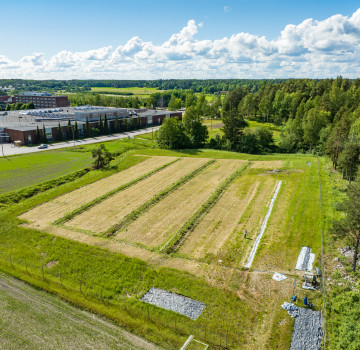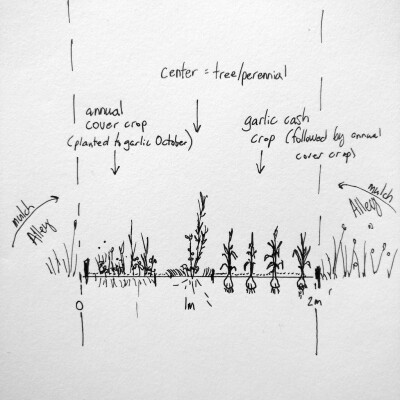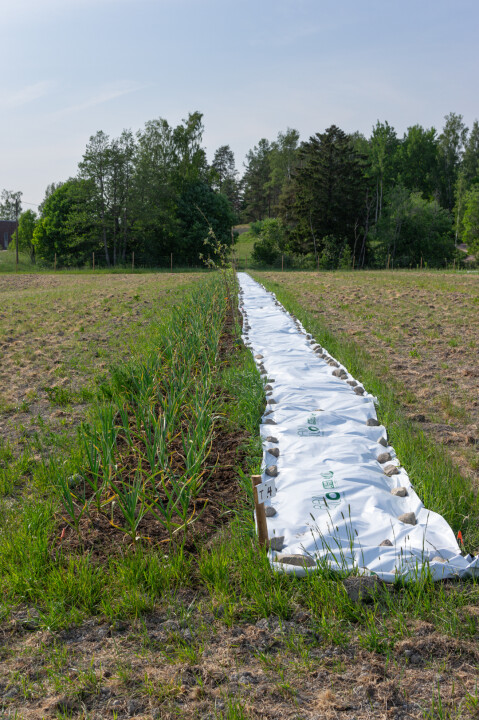Lill-Nägels Site Design
1. Introduction
Now that we’ve taken a close look at the site’s overarching context (click here for Site Analysis), it is time to turn to the design of the project itself.
This page has the following sections:
- Introduction
- What kind of system is this?
- Site Plan: Overview
- Site Plan: Details
- Irrigation System
- Conclusion
Please note that this page is about the site's design and may incorporate older photographs; for up to date pictures of the site, follow the project on Instagram or Facebook (Lill-Nägels Agroforestry); if you do not use social media, then the project's Timeline will offer relatively current photographs, followed by the site's management section (not yet published, coming winter 2023)
Although I have mentioned that one should not approach a project with a firm plan in mind, I have to admit that we were searching for a suitable location for an agroforestry project before having conducted a thorough site analysis.
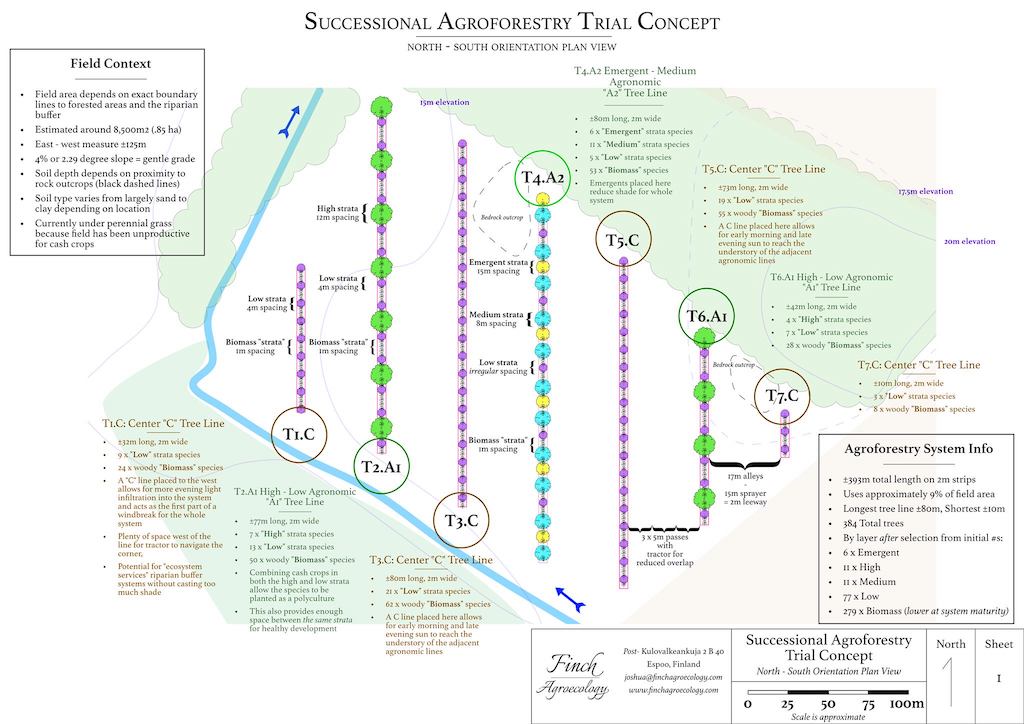 Early concept, before we thought about applying for a project, after visiting once and using remote information
Early concept, before we thought about applying for a project, after visiting once and using remote information
If this seems to contradict my advice it is because after more than a decade of research and applied agroecological experience- much of it right here in this area of Finland- I have acquired the skill to relatively quickly read the landscape. I have trained myself to view landscapes through those different lenses we just utilized to hone in on specific site characteristics.
This does not mean that the design we are about to look at was created on the first round. Quite the contrary. But this skill of reading the landscape allowed me to run through the most important design considerations (water, access, soil, solar energy) and green light the location for the kind of project we wanted to do. This is called fitting the pattern to the site. Agroforestry, when practiced at scale, is going to look (at first glance) relatively simple: straight or logically laid out tree lines (Keyline Design, for example), regular alley spacings, and everything adjusted for the expected equipment. There are really only so many ways you can actually put down the bones of the system.
Therefore it does not necessarily take in depth site analysis to determine whether agroforestry is physically appropriate. We already believe that agroforestry is ecologically appropriate in our biome and region, otherwise we wouldn't bother with the idea in the first place. What we don't know is what form agroforestry needs to take in order to meet the context dependent goals.
The important part of thorough analysis is the modification of climate and culturally appropriate broad patterns to suite the local, farm specific context.
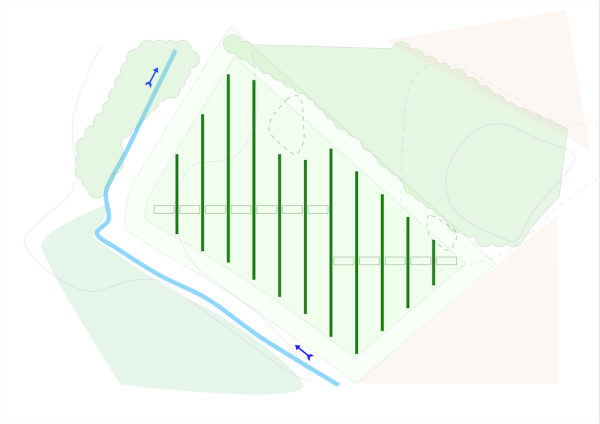
The system went through other iterations with different spacings and orientations
These details were only penciled in over a period of months. The design process itself may quickly reveal to you what kind of pattern you’d like to place in a location, but the iterative process of talking with project partners, studying the site on the ground over time, and allowing ideas to take form and have questions asked of them, is where the details begin to emerge. That doesn’t happen fast in cases where a new system is being implemented.
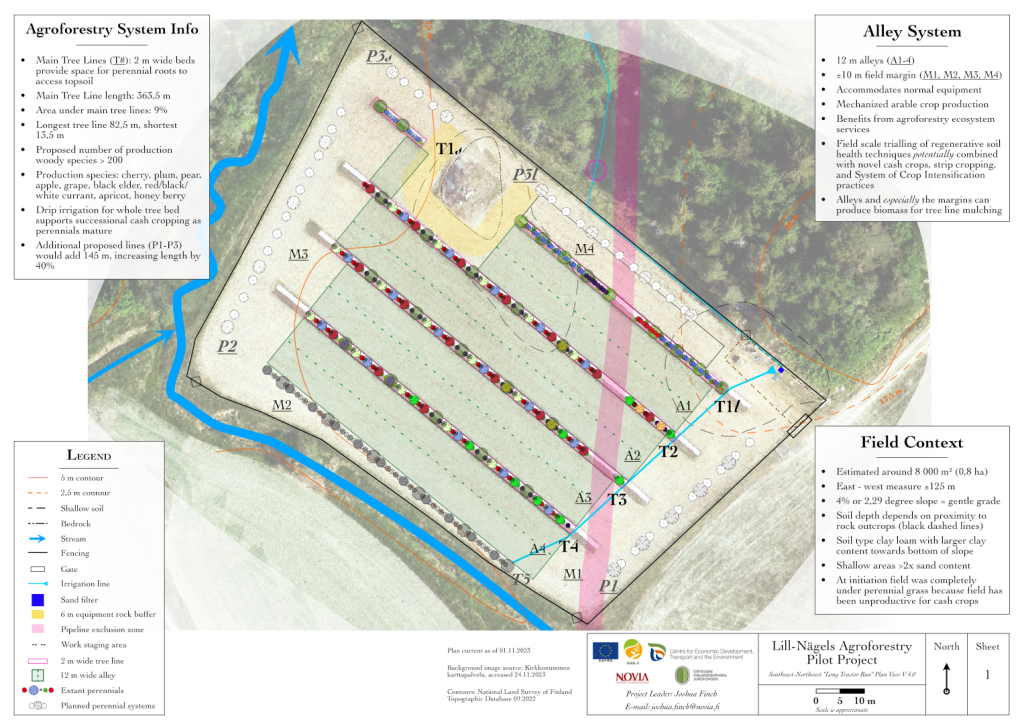
Most up to date version of the site plan, 05.12.2023; Significant improvements to the layout were made with input from Aurélie Noel, geomatics specialist and project leader at Novia
2. What kind of system is this?
Our project is a “successional silvoarable agroforestry” system. Let’s define these terms so we all start on the same page. Afterwards we can dive into the Lill-Nägels Agroforestry Project in detail.
(Note 2: an entire section of the website, which is a work in progress, is dedicated to the conceptual background for this project)
First, agroforestry. Yes, English is a weird language which means agroforestry needs to be addressed before the others. The definition of agroforestry that I want to use is straightforward: “agroforestry is the deliberate inclusion of woody shrubs and trees in agricultural systems.”
That means it is not accidental or unplanned. We want to judiciously bring woody species of plants into our fields to perform multiple functions.
An agroforestry system can be designed in many, many ways, and the other words in quotations above are qualifiers of the word “agroforestry” which more precisely define the kind of system that we have started.
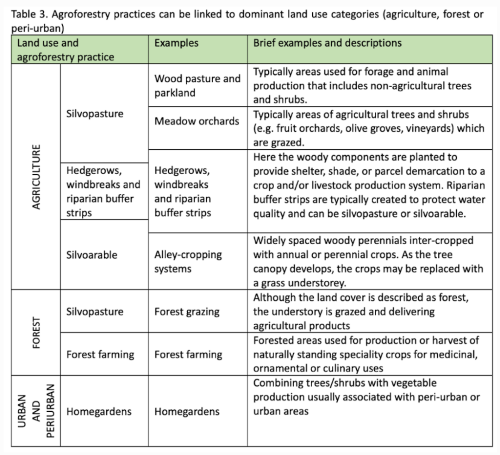
Agroforestry typology from Table 5 of the "Extent and Success of Current Policy Measures" report from the Agforward Project (link below) |
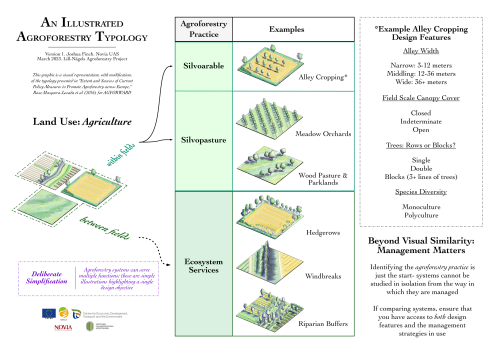
An illustrated version of the same typology |
Link to the "Extent and Success of Current Policy Measures Report" (2016) by AgForward.
The next word I need to explain is silvoarable. This simply means a system of field cropping that includes trees.
The general plan is to use the alleys- that’s what we call the space between the tree lines- to trial novel ways of growing cash crops on a broad scale using practices such as the system of crop intensification, strip cropping, adaptive grazing, and diverse cover cropping. The tree systems are of course of interest, but only utilize about 10% of the total area of the project.*
(12,24% if all the planned tree lines are created).
The specifics of how we intend to manage the whole system will be addressed elsewhere.
Finally, we reach the part that refers primarily to the trees: successional. Succession at its most basic means one thing leading to the next. In classical ecology it was thought that landscapes would “succeed” or move through time, from open disturbed sites to climax forest and stay that way.
(Note: A 50+ page report on the topic has been published by the project leader. See "Successional Agroforestry Trip to Denmark, October 2022" from our Reports & Publications section of this website)
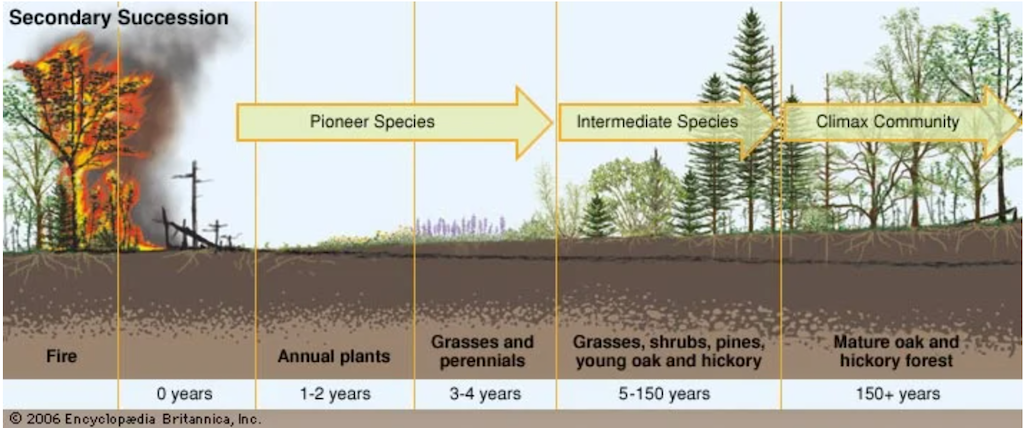
Secondary Ecological Succession by Encyclopaedia Britannica Inc. 2006. Access 24.01.2023
A more contemporary view holds that ecosystems contain many different kinds of small scale ecosystems (more usually known as ‘habitats’). These habitats exist in a dynamic relationship to the larger landscape and global earth systems and thus are only temporary. Which habitat develops and comes to predominate for a long period of time can sometimes be predicted easily, but more often than not it is a very tricky thing to say what any one place might look like in the future. Nature is always in a state of change- everything from weather and climate to the influence of neighboring ecosystems and their inhabitants would need to be taken into account.
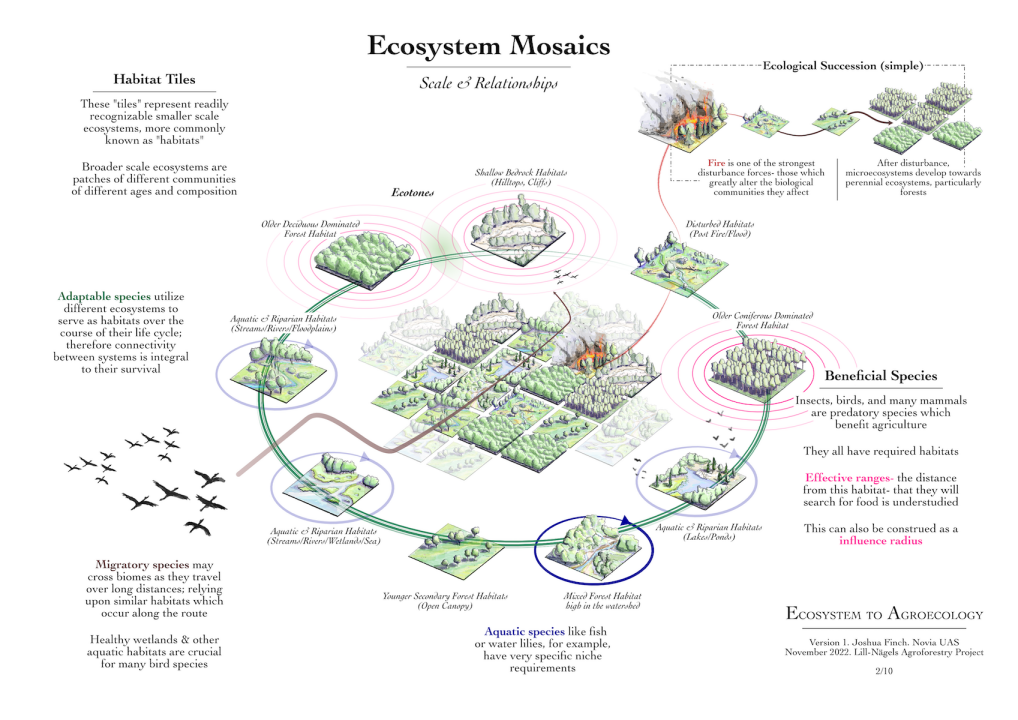
Slide from project's conceptual background (in progress) expanding upon succession in our biome
The power of this idea- whether looking at it from a classical or a contemporary standpoint- is that there are sets of organisms uniquely adapted to each “stage” or even stages of change. An organism in its niche will thrive, even if other organisms will not. With plants, there are many species which thrive in open, disturbed environments and can make a living without deep, high carbon soils and lots of shade. But once those plants accumulate natural resources over time, other species adapted to improved conditions can move in and begin to alter the site to their ends. Those early successional species- the ones that start the process- move on to another disturbed location (or stay put in the seed bank waiting for another disturbance event).
Hence the larger ecosystem resembles a patchwork of different habitats all in dynamic relationship with one another. The trick for putting the power of this natural process to use in agriculture is understanding the ecological niche of the crops we want to grow and then consciously & deliberately guiding the ecological community to create conditions favorable to our crops. This natural process does not rely upon large amounts of fertilizer being moved about, nor does it rely upon crushed rocks or minerals that change the pH or soil structure (lime, gypsum) to be hauled long distances and mixed into the soil profile. How to manage this on a commercial farm is, in some sense, what regenerative agriculture and agroecology is working towards.
Within reason, plants that survive in a certain area can adapt soil conditions to meet their needs. The less they need to change the soil chemistry the better chance they will have to grow and succeed of course. Still, plants can alter soil conditions quite dramatically. If our efforts do not alter the site as we wish, then we adapt our management and choose crops that suit what the location is capable of supporting. Successional agriculture (sometimes called “syntropic agriculture”) relies on the complexity of biological processes to make nutrients available, hold water, and reduce or eliminate pest problems- not inputs.
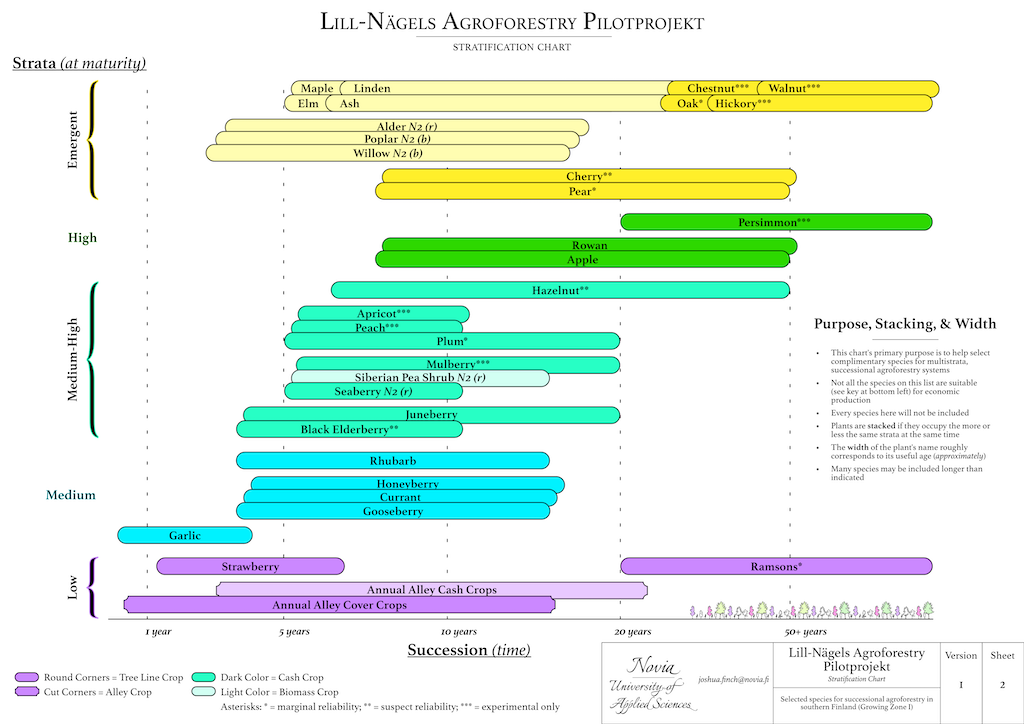
An early version of a stratification chart, useful for conceptualizing polycultures; note that "high" is often called the canopy
It can be useful to ask: is a field with 3% soil organic matter (like ours) really the same habitat as the very same field if it had 9 or even 12% soil organic matter? No, not at all. And it shouldn’t be treated as if it were a place with 12% if we are barely registering 3. The power of life to accumulate resources and alter the geology of the earth in spite of unfavorable initial conditions is a hallmark of succession. It is also a process that most farmers actively discourage through their management practices. We start at 3% and work towards building as much soil as we can with profitably in mind.
So, where does our site sit in this patchwork of development called succession? At the moment our site is in an early stage of succession. The soil is not very deep- that is, we have very little of the living topsoil where biology works in concert to support abundant species richness- and we have very little biological diversity. We are very much at the start of this chain of events. That means our design will utilize a lot of early succession species to alter the site conditions to become more favorable for our desired crops.
A “successional silvoarable agroforestry” system, then is:
- An agricultural system…
- in which trees and shrubs are included for agronomic and ecological reasons.
- Cash crops are grown in the alleys between the trees…
- and the whole system is managed to support the development of healthy soil through adaptive, dynamic relationships between living organisms and the site’s physical conditions
If you would like to know more about how the project conceptualizes this topic, we published a 60-page report the project manager (Joshua Finch) wrote about the topic of successional agroforestry, which can be found in full as a PDF here (internal Novia link).
3. Site Plan: Overview of the System
If you’ve been following along from the start, you’ll know that this field is about 8000 square meters (perhaps a bit less, measured recently as 7944 square meters). It has very good solar exposure but may prove prone to drought damage given its particular situation in the topography at the top of a small hill. With a relatively easy slope and regular shape, the field is suitable for machine use.
I have deliberately left a "key" to the different plant species off of the general plan view. There are >10 cash crops alone and, given the problems with displaying high quality images on the website, I do not intend people to use the plan view for more than gaining a general idea as to the site's main features. The section below this one concerns the details. Each tree line has a cross section, or profile view, which informs the viewer of the species involved. This way they can also be understood in relation to one another's strata.
Fencing
The site is surrounded by about 370 meters of game fence. The fence is 200cm high with 17 horizontal wires spaced 15cm apart. The lower section of the fence has tighter spacing to prevent smaller animals from entering.
Site Feature Labels
All of the features with number labels begin their count from the fence gate, which is located at the southeast corner of the site. The first tree line you encounter is the first tree line (T1). Likewise, the gate opens to the first margin (M1), and the first alley (A1) is partnered with the first tree line. Walking clockwise through the field the counting begins. Likewise, the start (0 m mark) of each tree line is where it begins from the first margin (M1). The perimeter tree lines, labeled P1-P3, are works in progress. This keeps things simple and allows one to interact with the site’s labeling in an intuitive manner and speak with normal English phrases.

Let’s look at the bones of the system’s features in turn:
- Margins
- Alleys
- Tree Lines
- Perimeter Tree Lines (will be added later)
Margins
When designing any agroforestry system- with or without the intent to use the machines- one needs to pay particular attention to the margins (the edges) of the field. This is where your project transitions from one system to another and, thus, its management is essential towards integrating your project’s “habitat patch” into the whole of the agroecosystem.
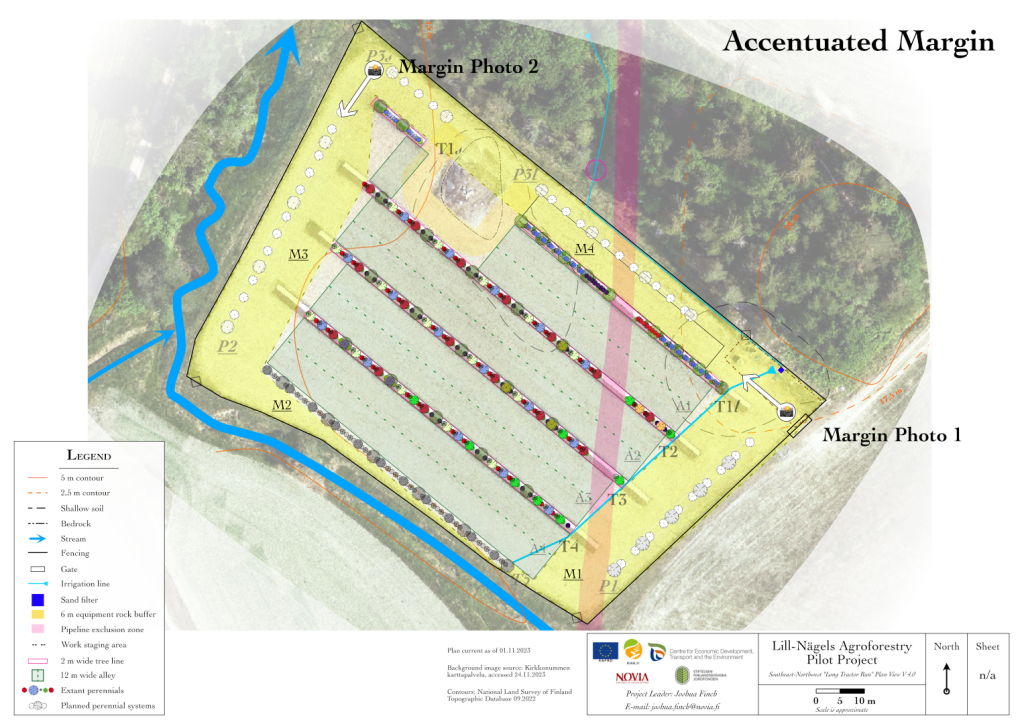
Plan view with margins highlighted and photograph directions indicated
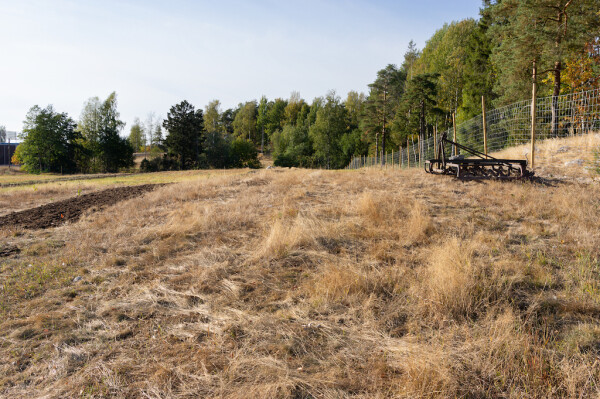
Margin Photo 4: 12.09.2022. Drought conditions on shallow soil just above bedrock in M4
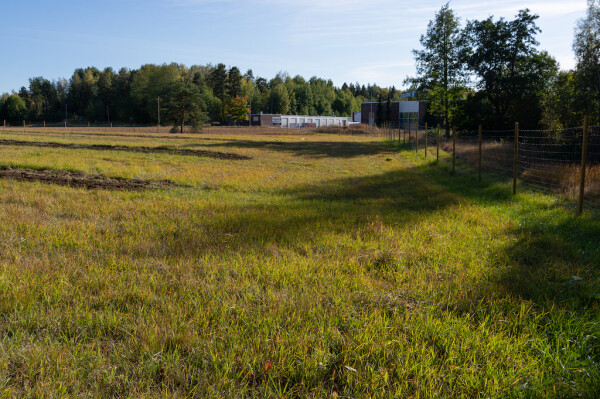
Margin Photo 2: 12.09.2022. Same field, same day, but in comparison we have healthier plants where the soil is deeper, M3
The margins are also where a lot of trouble can take place. Unwanted perennial species creep into fields, shade cast from trees outside the system reduce productivity, tractors turning on wet soil increase compaction: there are many reasons why margins aren’t looked at as the heart of the field besides their location.
So how did we approach the design of the margins at Lill-Nägels?
Note: The field currently has 15,5m wide headlands (M1, M3) as the perimeter tree lines have yet to be added. Headlands are the margins which give access to the alleys)
First, we knew that we wanted to use machines to manage the site as much as possible. That means those machines need to be able to move around, turn, and otherwise perform their tasks without undue micromanagement. What constitutes undue depends on the scenario. We decided to break the rules as a pilot project: it does not fully accommodate the widest implement we plan on using, which is a 12-meter wide sprayer. While you wouldn’t think that adding another four meters to the margins (2 meters from each edge of the field) would make much of a difference, it did when designing the tree lines into the system. We wouldn’t have enough room to fit as many tree systems as we want to trial. Fortunately sprayers are designed to be folded and can even operate while one half is lifted. This will impact the speed of applying foliar applications to the field, but the price is one we are willing to pay as a pilot project to gain the additional trees. After all, the systems we will implement in the alleys and margins are less novel than the tree line polycultures and, therefore, the information we want to generate from collecting data about those trees is more valuable than a few more square meters of alley or margin space.
Our system currently plans to use 10 meter margins (except in M2). This is wide enough to accommodate a tractor, a combine, or other machines that will be employed. At 10 meters wide, we can plant the system with the same 3 meter wide planter as the alleys. The extra meter is leeway- a bit of extra play in the system to help us avoid the fence and creates some peace of mind. Besides, the extra meter along the fence will likely be mown more regularly than the rest of the margins to help keep it clear.
Note: we have found 10 m margins to be only just large enough for a tractor and planter; with the redesign of the whole polyculture system, we may decide to use the 15,5m wide headlands version 4 of the plan created- this is one aspect of the project that is still undecided
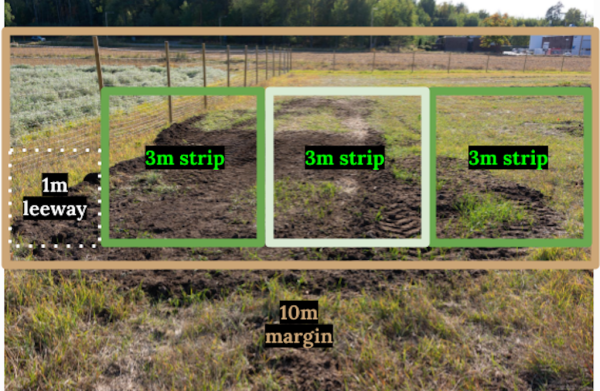
Not to scale, however, this demonstrates how the original 10 m margins were subdivided
- With version 4's specifications, the margins account for about 3150 square meters (±40% of the fenced area). We understand that this is a sizable bit of real estate that few farmers can afford to leave out of production, however, this is a pilot project aimed at generating information about novel systems, not a conventional working farm.
Second, we want to use the margins, but not for cash cropping. This is in part because of what I said earlier about margins usually winding up with the worst soil and issues from outside the system. It also makes it easier for us to more closely calculate the yields and inputs from the alley cropping. Since we will employ strip cropping, cultivating the margins with cash crops could turn into a bit of a planning headache. Again, this is where compromises need to be made for the sake of the whole pilot project: the site is not supposed to be a functioning farm, but rather a project investigating multiple ways of bioremediating soil profitably. As a pilot project, it is necessary to try some things which may not be economically viable for other farmers in order to gain valuable knowledge. Additionally, do not forget that, until now the site does not produce any cash crops because it was removed from production: this is not a functioning arable field that we are "removing" yield from. Lastly, if this pilot does begin to produce profitable results, scaling the system in reality would mean that you would not be forced to play the tree lines against the whole system as there would be plenty of space for trees when measured across multiple fields. By spreading the tree lines out across part of an entire farm, one would have enough trees to collect data from in such an expansive scenario.
By not doing more of the same, we will be able to plant the margins with biodiverse perennial meadow species. Although we do not have plans in the near term to integrate animals, we would like to have the possibility to integrate animals and what better way than to start growing a healthy meadow? It is much better to design the possibility of something new into the system from the start, even if you don’t think you will use that function right away, than to maximize the initial enterprises at the expense of the future. We’ll touch on that again when it comes to alley cropping.
So if we are not going to grow cash crops and we are not going to graze the margins yet, what practical role do they play in regards to the whole system other than serving as a place to drive around? One obvious function is that a biodiverse perennial pasture can be mowed, the biomass gathered, and used as a source of mulch for the tree lines. This may prove critical as we do not intend to buy any more than the one application of compost for the site. The reason for the one time application of compost is addressed elsewhere. This project is striving to see if the majority of the site’s needs can be generated in-situ. The margins can provide a backup to the primary source of mulch, which will be the cover crops grown in the alleys adjacent to the trees lines. We do not expect our 2 meter wide tree lines to produce all their mulch needs, at least not in the early years.
While the total amount of space dedicated to this may appear extreme, I want to point out that this is in part because of the size of the field. As you scale these systems up the margins diminish in size quite a lot. For example, another field on the farm- a 3,4 hectare square- would see about 20% of the space dedicated to 10 meter margins. The difference between 35% and 20% going to a dedicated edge system is quite a lot. Although the space relegated to the margin would be significantly smaller, we would likely crop it with lessons drawn from the pilot project.
Lastly, let’s not ignore the value of a biodiverse perennial meadow surrounding the site. Managed properly it will increase in fertility alongside the other treatment areas (tree lines, alleys) and will serve as a habitat for beneficial organisms, infiltrate water up on the top of the slope and help act as a perennial buffer to absorb any mobile nutrients leaving the site. The indirect benefits of habitat creation (both in the vegetation and below ground) may not be easily parsed out in monetary terms, but I fully expect to have less pest pressure in our project due to this management strategy. Of course, once the soil improves, we can also decide whether or not we would like to try cropping the margins as well or bringing in animals. Only the changing context will tell.
Alleys
Once the margins had been set, it was time to decide how wide to make the alleys. Deciding how wide to make the alleys is wholly related to the project goals. This project is intended to showcase how successional agroforestry can be applied at moderately large scales- the design implemented here should be applicable to a system measured in hectares, not only in sub-hectare fractions. Therefore the design is not focused on creating a closed-canopy agroforestry system. Those kinds of systems eventually turn fields into forests or orchards. Our goal is to design a regenerative system that allows the field to maintain and, hopefully, increase the production of grains, pulses, fiber, and other broad acre crops that the farm already produces.
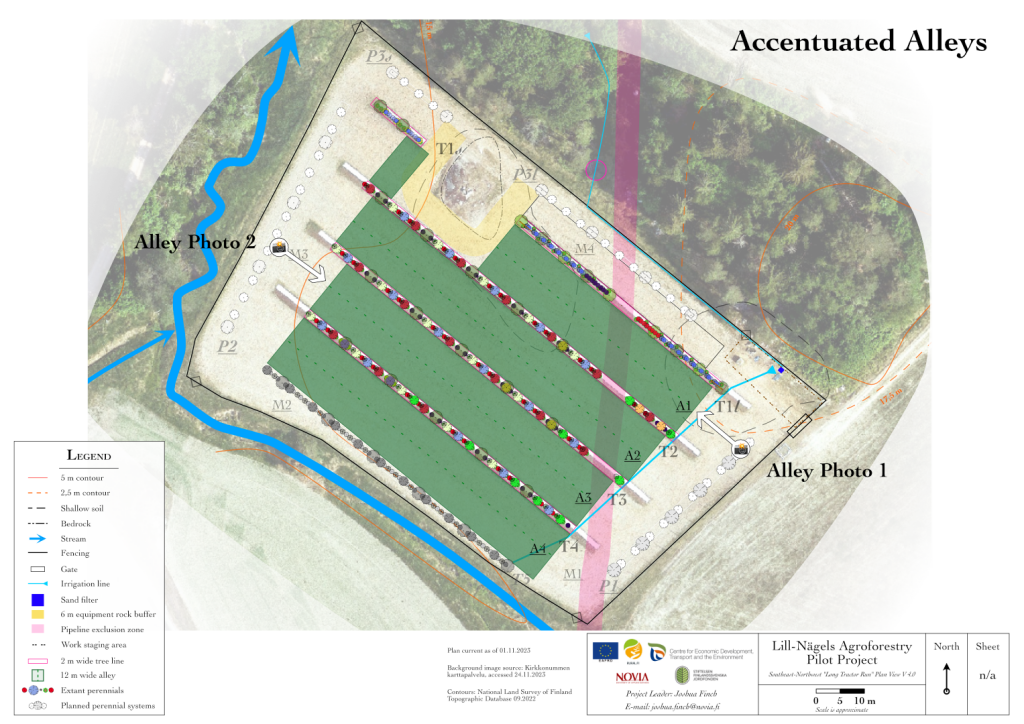
Plan view with alleys highlighted and photograph directions indicated
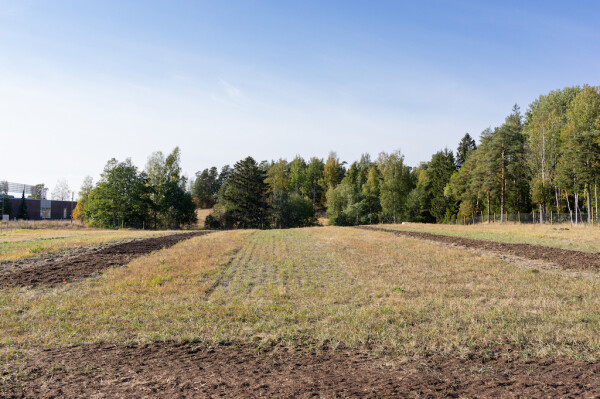
Alley Photo 1: 12.09.2022. Looking down (northwest) A1: regular spacing provided by GPS guided field work
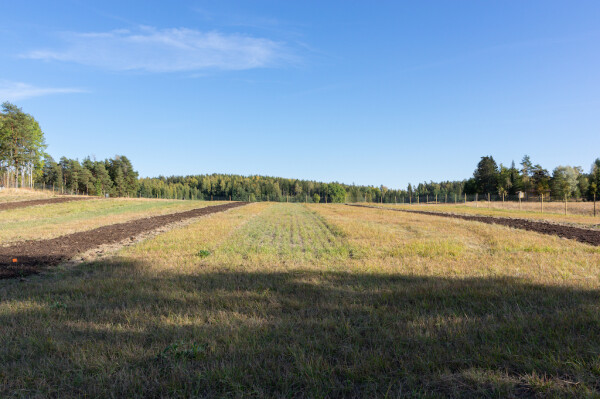
Alley Photo 2: 12.09.2022. Looking the opposite direction down A3, the gentle landform of the site is evident even as the aspect of the slope changes to face northwest
With that in mind we needed to ensure that the spacing between the tree lines would allow for sufficient sunlight into the alleys for the long term- allowing the cultivation of full-sun loving annual cash crops. At the same time, we needed to balance the desire for practical cash cropping in the alleys with the pilot nature of this project: if the alleys grew too much we would only be able to deploy two or three lines of trees in the system. That wouldn’t produce a lot of information about the application of these concepts to the tree systems.
Alley cropping may not be widely practiced yet, but my experience from designing and managing my old farm at Lillklobb for six years granted me enough confidence to decide on twelve meter (12 m) alleys. Lillklobb was designed with agroforestry systems adjacent to at least one side of a market garden field block and had varying light levels throughout the site. Vegetables were never more than 12 meters from a perennial system. Although none of the market gardens had as much solar energy available as Lill-Nägels, we were able to crop multiple successions of sun-loving vegetables. So I knew that twelve meters would be sufficient for an open canopy silvoarable system.
(I do think that twelve is perhaps the minimum for an open canopy system and I was only able to settle on this width in part because of how I intended to design the tree systems: wide spacing between trees creating variations in height)
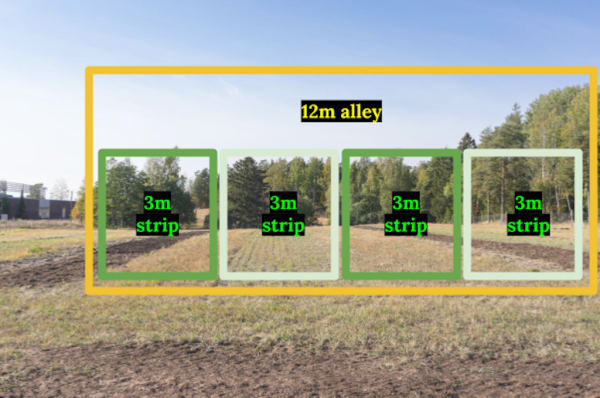
Not to scale, however, this demonstrates how the 12 m alleys are subdivided
As you can see here, a 12 meter alley allows for the full working width of a sprayer applying biostimulants and foliar nutrients. Twelve is also neatly divisible into four 3-meter-wide planting strips, which allows for strip cropping.
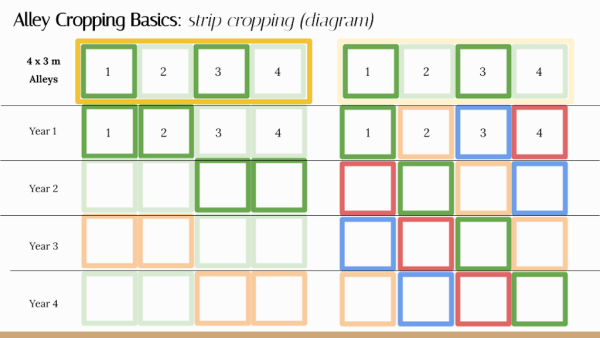
Conceptual diagram of rotations within strip cropping: different colors represent different crops; on the left, strips have been paired, while on the right each strip has its own crop
Strip cropping is an important part of this project and will have its own section devoted to it in more detail. That said, even if we weren’t sure we would employ this method, again it makes sense to build the functionality into the system during the design phase rather than wish it were available some time in the future. For example, a 15 meter alley would also work with our planter and there are 15 meter sprayers available. However, you wouldn’t necessarily be able to “pair” strips together with an odd number of strips and would lose out on an easy method to simplify crop planning choices. In a nutshell that is why we have an even number of strips.
If we skip ahead and take in hand the two meter wide tree lines for the sake of understanding the alleys, we can see that four alleys fit into our system. The fourth alley (A4) and the fifth tree line (T5) are places where we are taking a bit of liberty with the design and will be explained more during management.
- With version 4's specifications the alleys account for about 3318 square meters (±41,7% of the fenced area). This figure would increase if not for the 6 m rocky outcrop buffer cutting out about 473 square meters from multiple systems.
To conclude with the alley design it is clear that even with a small sized field- and a large area penciled out as margins- that a large area of the field is still dedicated to testing novel means of broad acre crop production.
Tree Lines
The last major part of the design are the tree lines. The current design of the system includes two different kinds of tree lines.
- The tree lines proper. There are five of these, T1-T5. Each of these is oriented in the same direction and has an alley between them. Though they differ in length, they have the same width and function- produce diverse cash crops
- Perimeter tree lines. There may be three of these, P1-P3. These were added later in the design phase when I decided that I did not like having the edges of the site left open. Although P1 and P2 will not be wide enough to create and effective windbreak, they will serve as a slight wind break. P3 will allow us to blend the system into the edge of the small woods on the northeast side of the site. Think of the perimeter tree lines as adding just a little more complexity to the structure of the system.
Note that the design details come later in this page.
Setting the specifications of the margins and alleys doesn’t by itself tell us what direction the alleys or tree lines are going to be oriented. Typically in our context one is advised to plant tree systems along a north-south axis. There has been a lot of research done into the effects of shading on the inter row (alley) growth and you’ll find that this maxim is repeated as common knowledge. In general, it may serve as the best starting template, the baseline against which changes need to be compared, but in our case a rigid north-south axis was shelved in favor of what you see here.
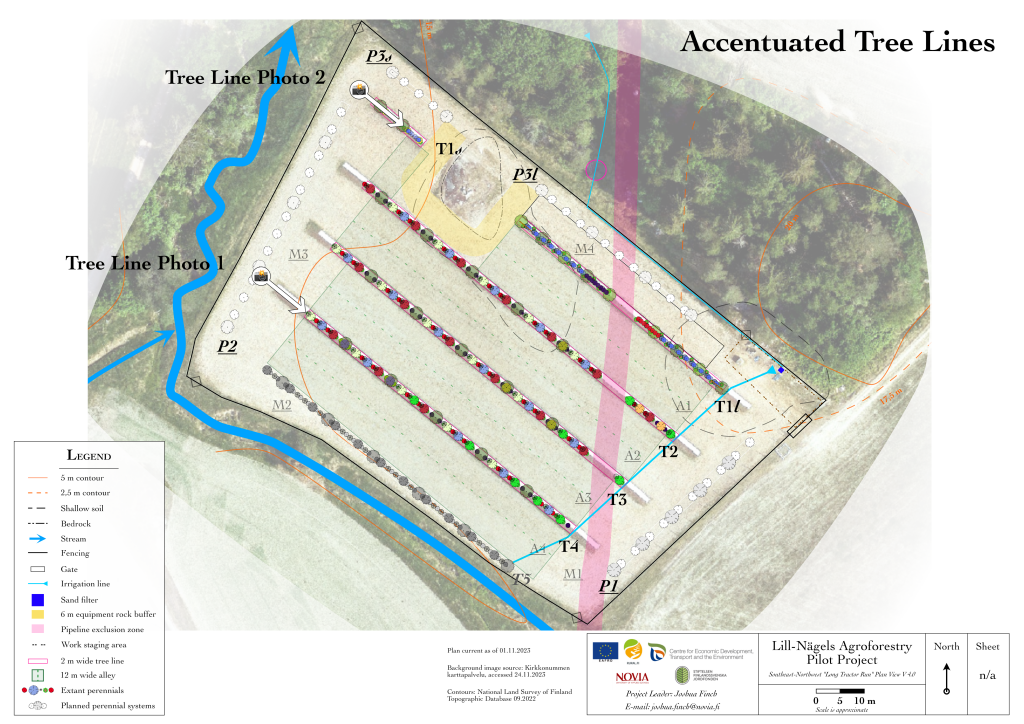
Plan view with tree lines highlighted and photograph directions indicated
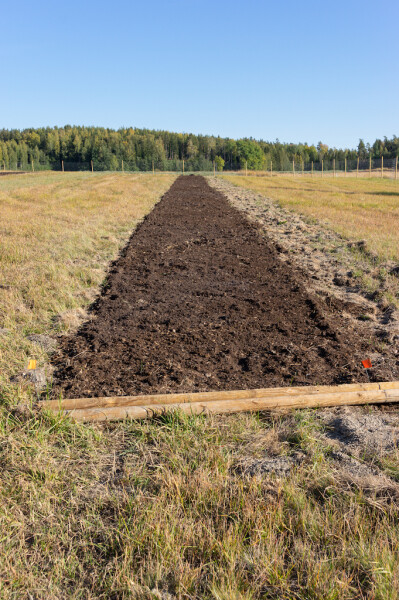
Tree line photo 1: 12.09.2022. Looking southwest down T4 at the bottom of the slope
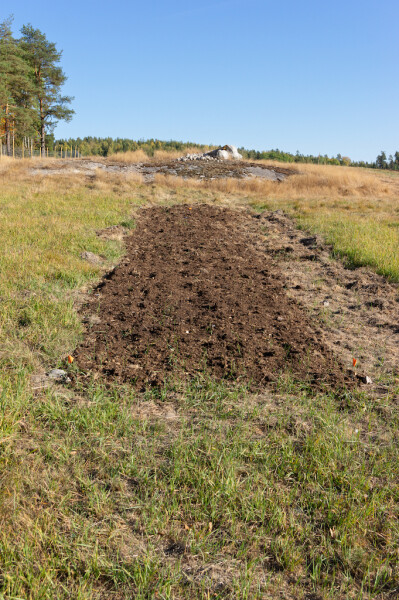
Tree line photo 2: 12.09.2022. Looking southwest down T1 short; this is the shortest tree line at only 13m; T1 long is beyond the field of view on the opposite side of this rocky outcrop
Here are a few reasons why we changed the orientation of the trees at Lill-Nägels:
- Agroforestry lines serve as perennial strips in silvoarable systems and their deep perennial root systems help infiltrate water moving along the soil surface
- Planting the tree lines more or less on contour or, preferably, using Key Line Design, ensures that the tree systems can perform this function while remaining logical for mechanization
- Key Line Design was investigated for this field, but it doesn’t make sense because simple straight lines will give us nearly as many benefits as a more elaborate system would
- A north-south orientation would reduce this “passive” benefit of silvoarable systems dramatically and orient the alleys for erosion downslope
- Planting the tree lines more or less on contour or, preferably, using Key Line Design, ensures that the tree systems can perform this function while remaining logical for mechanization
- A north-south orientation would increase the number of tree lines but not the total area devoted to them
- With a greater number of tree lines (and alleys), a lot more turning would be required in the margins
- The margins would have increased compaction risk
- In addition, the margins would likely need to be increased in total size to reduce dismounting and adjusting the sprayer
- Longer tractor runs that happen to correspond well with the contour of the land decrease annoyance (an often overlooked factor in farm design), allow more efficient use of the machines, and allow the passive benefits of trees as water harvesting features to be expressed
Now that we know which direction we’d like the tree lines to run, how did we decide to make them two meters wide? A two meter bed width was decided upon for a few reasons.
First, we plan to cultivate broad acre annual crops in the alleys. These species are not very well adapted to growing alongside larger trees and shrubs that the system will eventually accommodate. As we do not want to create a closed canopy agroforestry system, we do not actually want the root systems of the perennials to occupy the valuable topsoil layer in the alleys since they will likely outcompete the annual cash crops. That means we will need to employ root pruning along the edges of these tree lines to prevent the trees from building strong surface root systems in the alleys.
Second, if we employ root pruning, then the trees need to have enough undisturbed soil to build at least a small network of surface feeder roots and the soil microbiome they need with our project goals. Recall that our objective is to bioremediate the soil with diverse plant communities supported, but not propped up by, outside inputs. If we were to use both root pruning and put the trees in narrow beds, they’d have very little space to develop the relationships with soil biology necessary to test this idea. In addition, we would lose out on the ability to utilize or leverage the input of compost and mulch to design a successional cash cropping system within the tree lines themselves. Putting annual cash crops next to the trees may prove more difficult than expected, but it is the design we are testing.
|
Sample sketch of a tree line's cross section in the early years
|
T4 a few weeks before garlic harvest 2023 showing the division of the tree lines into three sections |
Sample sketch of a tree line's cross section in the early years
Third, successional agroforestry also means moving from one cash crop to the next as the system changes through time.
In typical successional agroforestry systems (although this makes them sound as if they aren’t actually exceedingly rare), the trees are planted in much more narrow beds. The reason for this is that they are usually designed to move towards a closed canopy agroforestry system and thus, the space between the trees (the alleys) is very small. The total number of tree lines, then, increases many times over what we have. That means what is planted in those tree lines also changes significantly: some of the lines are meant only for early succession cash crop production. Thus, instead of a single two meter wide tree bed, you might have three 70cm beds with a few meters between them.
The typical successional agroforestry system, with its goal to close the canopy and move into a forest-like ecology, is very different from our open canopy system that more resembles a savannah ecosystem. But we still want and need the dynamism that comes from high biodiversity in both cash crops and support species.
With a two meter wide tree bed, we can safely place the trees right down the middle. Doing so gives the trees access to one meter on each side to develop those surface feeding zones over time. It also leaves enough space for two 75cm cropping beds. That is exactly the size I am used to using at my old farm with diverse market gardening.
Any agroforestry project requires investment in the trees and soil. For me, it doesn’t make any sense to plant trees and trees alone while also investing in compost, mulch, and maintenance. The trees are entirely too small to make full use of those resources and the expenses are not going to be offset for a long time. Instead, we can use the space adjacent to the trees to grow early succession cash crops that can put those resources to use. The care that goes into growing those early cash crops also benefits the trees because they are paid more attention (attention is the most valuable resource), weeds are kept down, and the motivation to continue caring for the system is increased by the positive reinforcement of having early marketable crops.
As the trees and other species mature, their canopies will expand and it makes sense to have a nice wide tree bed to fit them: for example, a healthy rhubarb plant can easily grow two meters wide. By giving them that much space to begin with we will have a lot less interference from the tractors and machines operating in the margins.
- With these specifications the tree lines account for 363,50 linear meters or 727 square meters (9% of the fenced area). I think this is a good target figure for open canopy systems.
So while our successional silvoarable agroforestry site plan is not as complex as a typical “syntropic” system, by understanding the patterns I was able to mix theory and experience together to create a system that is more dynamic than it would appear on the surface.
4. Site Plan: Design Details
Now that the framework of the system has been explained, let’s look at some of the details regarding those features.
Margin Design Details
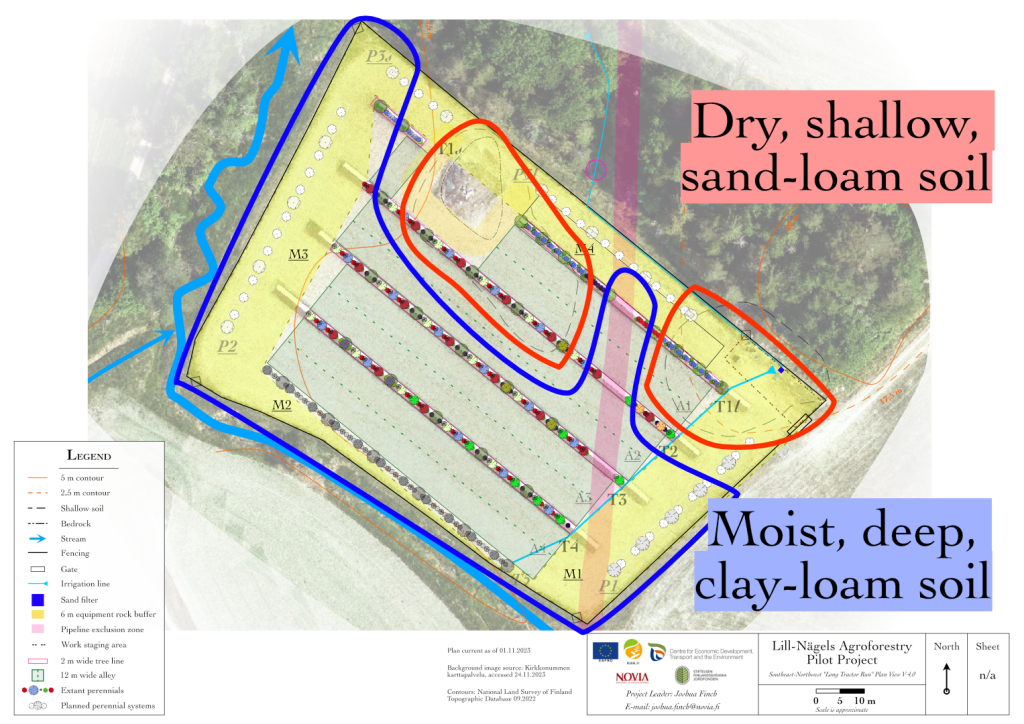
Plan view with soil conditions highlighted
This feature is the most straightforward of all. The site has areas that are both dry and seasonally moist. Even if the management of the system improves soil fertility as we expect, differences will remain because they stem from soil type and depth. Since we want to plant a perennial pasture here with high biodiversity, we are looking to plant three categories of plants:
- Generalist species. These will form the basis of the pasture and grow everywhere in the margins. These include species like red and white clover, perennial pasture grasses, and plantain.
- Dry (Xeric) adapted species. Given how the margins wrap around the soil conditions, dry soil adapted species will be mixed with the generalists (most of M4, a portion of M1).
- Wet (Hydric) adapted species. Despite the perennial grass cover, the soil is not yet in a healthy state. I have observed standing water in many places in the field even 12 hours after significant rainfall in the early spring of 2022. Therefore we will invest in planting perennial meadow species that are adapted to these locations (M3, M2, about half of M1).
Alley Design Details
The alleys are pretty straightforward as well, at least from a design perspective. The management of the alleys is something else and, as suggested elsewhere, is covered in a different part of this website (not yet available).
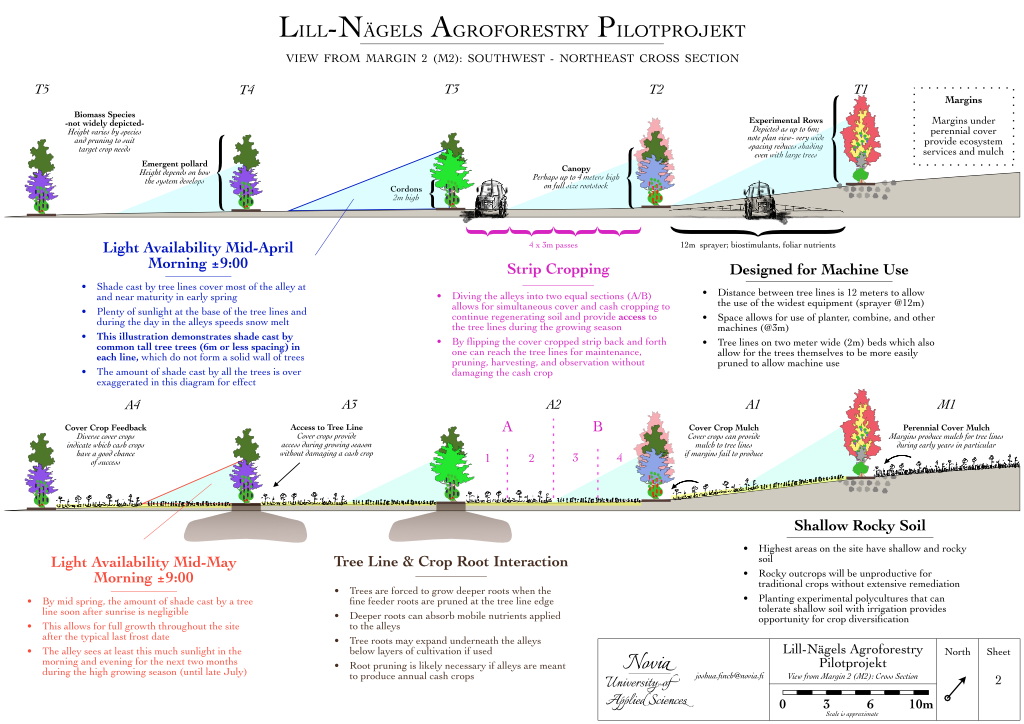
Note: The details of this graphic are out of date. Illustrative views from M1 highlighting different aspects of the design
There are two things in this graphic that have not been addressed elsewhere already:
First, the importance of using strip cropping to provide access along one side of the tree lines, especially later in the project’s timeline. A mixed cultivation of perennial crops in the tree lines means that people need to be able to reach them during the whole growing season. Harvest windows will come and go and it would be a terrible thing if one needed to drive a tractor and damage, say, a wheat crop. Therefore, by applying strip cropping, we can always ensure that one side of the tree beds is in a diverse cover crop.
While this may sound like too much of a good thing- cover crops are good things- let’s keep in mind the starting point of this project. As explained elsewhere, the soil organic matter is in the 3% range. There are compaction layers right where we would expect from plowing in the past. The amount of exposed bedrock has increased during the 20th century. This is not a field that is in a prime state of production, regularly producing 6+ tons of wheat per hectare. This is a field that was deliberately removed from production because it was no longer up to the task. If photosynthesis through diverse plant communities is our primary tool there are few better ways to do this than to use cover crops.
“Losing” at least one three meter wide strip each season to provide access to a biodiverse, likely profitable, tree system is not going to greatly affect the overall productivity of the site. On the contrary, having to trample through a cash crop in the alleys to check in on the trees is going to cause problems.
Second: cover crops as mulch. The margins have already been set aside as a place for mulch production for the trees. They cover >3x the surface area of those tree systems. This should be sufficient for producing mulch. However, the margins aren’t positioned well to provide mulch without moving the biomass from the edges to the middle. This would not be an insignificant cost: organizing mulch is time consuming. Eliminating as many steps as possible from that task is important, which is why the margins are a back up to the alleys.
As opposed to the margins, the alleys are directly adjacent to the trees. If we grow full season cover crops, we can mow them and rake the biomass to the tree line as mulch much more efficiently. The alleys are >3x the area of the tree systems, so there is going to be a good biomass to production ratio here as well.
Together the margins and alleys are >6x the size of the tree systems. We should have ample opportunity to “hay” either the margins or the alleys under cover crops to provide sufficient mulch in our climate. This is an incredibly important aspect of this design: haying can be extremely detrimental to the soil and plant health. Overzealous removal of biomass from the margins and alleys will degrade the soil. We need to have a system that allows us to choose where to harvest mulch from without exploiting any one area of the site. A final note on the production of mulch, which should be given its own treatment elsewhere as the project develops, is that in our climate we do not need to have exceptionally deep mulches. The most recent estimates of soil carbon flows point to root exudates and soil microbiology accounting for at least 60% of soil carbon, leaving a sizable, but smaller, portion to carbon being introduced from the soil's surface. Deep mulches are to be avoided also because of rodent habitat in the winter. This is something that our project will need to work on.
Tree Line Design Details
Turning now to the more complex system: the tree lines and their polycultures. We have two main types of tree lines: tree lines proper (T1-T5) and perimeter tree lines (P1-P3). Tree lines which have been planted are colored in the diagram below. Tree lines which are still in the design stage are black and white. Of those, you'll notice that T5 appears more complex than any of the perimeter tree lines- this is because the P-lines are using placeholder patterns from the early design stage. Below is a summary of the sizes of each tree line and the design intent.
| Tree Lines: Size and Intent Chart |
||||
| Tree Line Name | Planting Year | Length (m) | Surface Area (m²) | Design Intent |
| T1 | 2023 | 54,5 long / 13,5 short | 109 / 27 | Grape Trial |
| T2 | 2023 | 82,5 | 165 | Main cash crop |
| T3 | 2023 | 77,5 | 155 | Main cash crop |
| T4 | 2023 | 70,5 | 141 | Main cash crop |
| T5 | Design stage | 65 | 130 | Riparian buffer |
| P1 | Design stage | 40 | 80 | Short rotation coppice |
| P2 | Design stage | 54 | 108 | Nut Trial |
| P3 | Design stage | 42 long / 15 short | 84 / 30 | Undecided (more grapes?) |
If we focus on the tree lines planted in 2023, we can see from a first look that T2-T4 share a common design intent and therefore polyculture pattern, while T1 is unique. The connection between the intent and planting pattern is clearly visible in the plan view below. Initially I planned to change the polycultures in every tree line based on the underlying soil conditions, but decided before planting that it would be much more straightforward to keep each tree line with a similar pattern down its entire length. Now we will be able to see how the same pattern of species interacts with the sand-loam or clay-loam soils. The species and their relationships to one another are covered in each tree line detail.

One thing to note while on the plan view: I’ve “clustered” fruit tree species as much as possible across multiple tree lines rather than assigning them to a particular line of trees. Clustering across alleys should aid pollination. For example, the apples (bright green) are few in number and concentrated in the southeastern part of the field. While it looks strange, they all are within a 40 meter diameter circle. If I were to plant all of the apples in only the fourth tree line and continued with the alternating species pattern, they would require a 63 meter diameter circle. That’s 2.5 times as much area for bees and other insects to move about in order to pollinate just nine trees.
In typical successional agroforestry systems, one would of course pay attention to underlying soil conditions as well as all of the rest of the site’s context constraints and opportunities. Those farms are often designed, as mentioned before, with many more tree lines than we have. In the same amount of space between T1 and T5 there would likely be about 14 tree lines instead of 5 (3,5x). With less than 8 meters between trees, and that is being generous, a typical system would see the patterns used to array the desired species alternate tree line by tree line according to stratification in order to filter light through the system as it closes canopy.
This was not necessary in our situation because we are aiming for a savannah-type agroecosystem with our 12 meter wide alleys. The goal is to have as close to full sunlight as possible across the entire area of each alley to allow for the production of broad acre cash crops with mechanization, which works well with semi-pedestrian orchard pruning and tree training.
As we go through the design of these tree lines, there are some important things to keep in mind:
- The designs are illustrative, reality does not look like drawings
- T5 and P-line designs are subject to final revision
- The designs are focused on the target cash crop
- I’ve kept the systems deliberately simple to facilitate scaling up to a larger system
- There are a lot more biomass or support species included in this system
- We are fully aware of the challenges posed by incorporating support species into the mix
- We do not encourage others to plant support species like this in their agroforestry systems
- The entire idea of the project is to try doing something that is very rare, which is why it is interesting
- About 1000 acorns alone were planted in the fall of 2022
- More than 200 willows were planted in spring of 2023
- Adaptive management means that we will likely trial a few different pruning techniques on the target species: species form and height are conceptual
- The Lill-Nägels project has a CSA component in which members will pick their own produce
- Part of the experience is going to a biodiverse system and picking fruit from your adopted section
- We therefore do not need to prioritize labor saving designs because the labor intensive harvesting is part of the package
- The produce will have a lower cost to the CSA member than it would if hired labor was required, which would change the planting pattern
- Successional agroforestry planting patterns are still novel in our climate and these designs are simply a starting point for further research
- If you’ve skipped to this section without attending to the conceptual framework for bioremediation of soils through photosynthesis and diverse ecological communities, I’d encourage you to go back and acquaint yourself with what the goals of this project are because the species selection and arrangement will not make sense otherwise
Selected Species List
This is a list of the main tree and shrub species for the site. It is not exhaustive of everything we will plant. Strata is based on light requirement and not height.
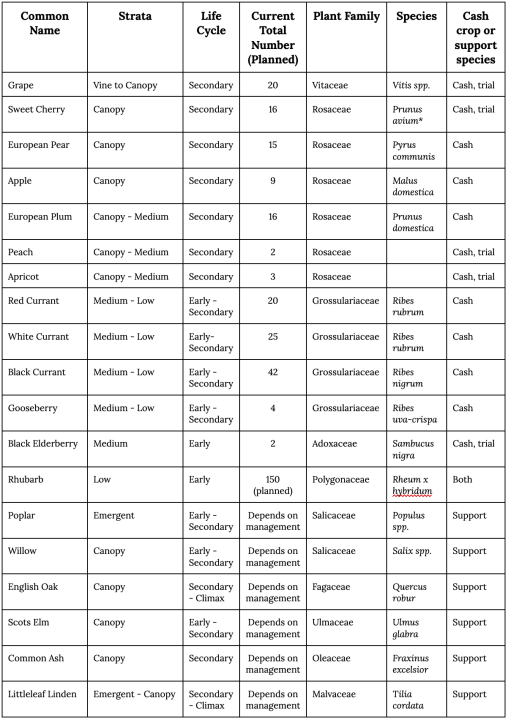
Tree Line One (T1) Cross Section: Trellised Crops on Shallow Soil
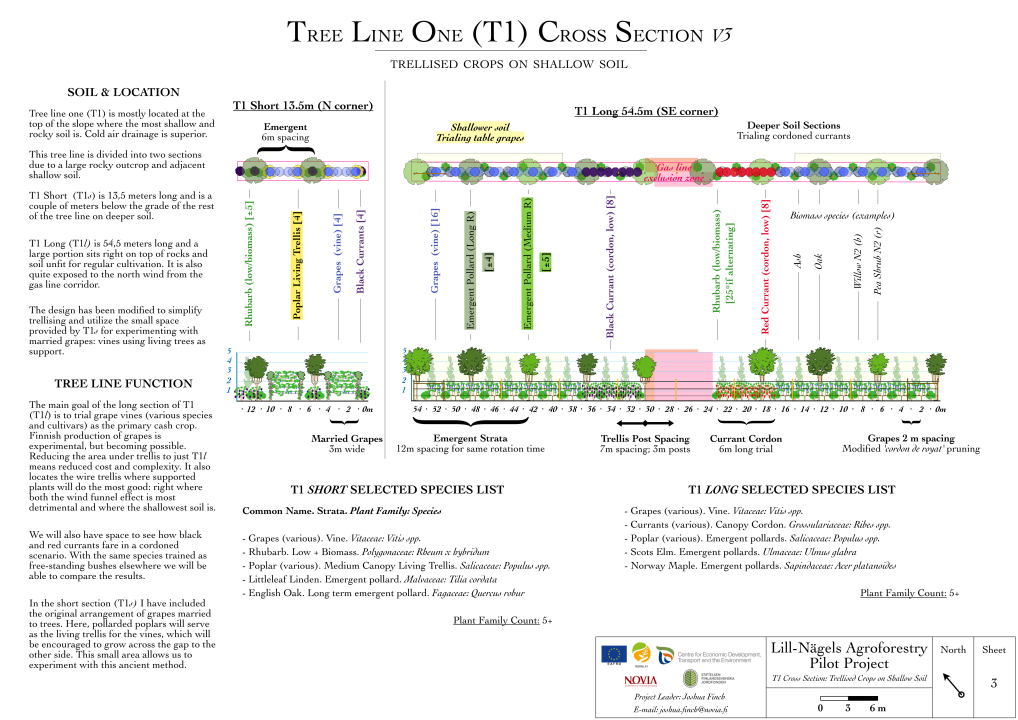
The first tree line is split into two sections. The large bedrock outcrop necessitates a break in not only this tree line, but also the cultivation of A1, M4, and P3.
T1 combines a trial crop of grapes with currants. Each section of the tree line has at least 5 plant families represented in the illustration and actual biodiversity will be a lot higher once we consider the species included from seed, the inclusion of short lived cover crops grown alongside, and low strata perennial herbs. The biodiversity is critical to activate the soil food web and a more comprehensive drawing would simply get too crowded.
I’ve labeled the sections T1 Long (T1l) and T1 Short (T1s). Since the soil is deeper in the short section, we’ve correspondingly changed the training pattern to trial "married" grape vines, which will grow much larger than those on the trellis.
T1 Long Design
Shallow soil conditions prevail here and the gas line exclusion zone removes a sizable portion of the deeper, clay loam soil from woody production. T1l will not be very conducive to growing many of the fruits and berries that we’d like. So I’ve taken some liberties with the design and tried to bring out the strengths of its location in the field: shallow soil, but high in the system and relatively well protected from wind means that it has a warm microclimate.
Our target crops are:
- Table grapes on 2 meter high trellis on top of the shallow soil
- Currants of all types also trained as cordons to the same trellis where the soil is deeper
- Rhubarb and perennial herbs in the low strata, planted atypically in the 75 cm beds to either side of the center
Each grape will be grown as a double cordon, meaning from one upright stem we will train perennial branches along the wire to provide a scaffold from which the young shoots will be grown. We have chosen to space the grapes every two meters along the wire.
Given the expense of the trellis, the design reduces the overall complexity and adds some biomass trees on 6 meter spacing. In the profile above, I have indicated that we will like alternate the pollard rotation time to keep enough sunlight coming into the system for the grapes in our climate. Additionally, thinner biomass trees are indicated which will be cut out through "over browsing" at a later point, leaving long term biomass production on wide spacing.
There has been some investigations into cordoning currants in our climate. Currants will be trained as bushes in the rest of the system, while here we will arrange them onto the trellis. This way we can compare the two systems in the same field.
T1 Short Design
The concept of marrying grape vines to trees is an ancient system of producing grapes without dead trellises. It has fallen out of fashion as mechanization has improved the efficiency of monoculture vineyards. However, at our scale, we want to give this a try in part because the whole system operates as a CSA. We will not mechanize production of grapes in this project so we can make being a member more interesting by using this method. Reasons for trellising the vines as opposed to using living trellises abound, but the biggest reason for doing so is not competition but labor cost savings. The living trellis will be more effort to manage, but it will add to appeal and the tree’s prunings will be valuable sources of mulch for the system.
Instead of having a continuous wall of grapes growing up poplars or maples, I have added a small gap to allow for the placement of long term biomass species grown as pollards. In the gaps we also have black currant bushes filling out the low strata.
T1 Crop Succession
T1: Garlic -> Rhubarb -> Grapes / Currants
T1 Cultivar Selection
Grapes:
- Juodupe
- Supaga
- Zilga
- Jadviga
Currants:
- Blanka (White)
- Titania (Black)
- Rovada (Red)
- Viksnes (Red)
Tree Line Two (T2) Cross Section: Crops on Mixed Soil Depths
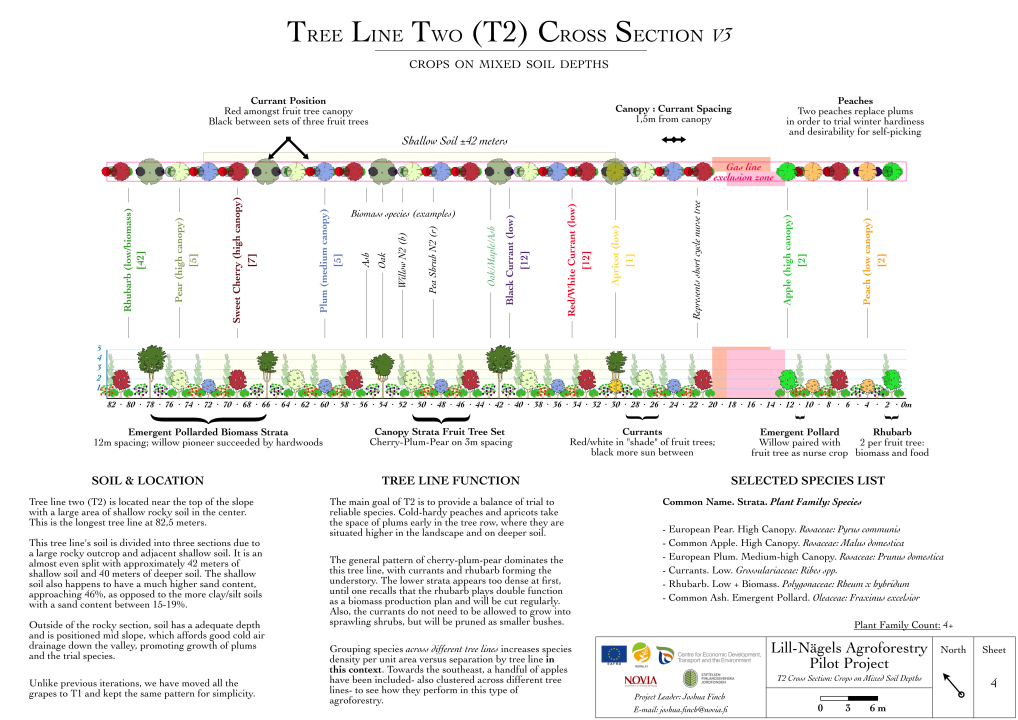
Tree line 2 provides a balance of trial and reliable species, making it the first of three tree lines (T2-T4) that utilize the same planting pattern. This main cropping pattern will be described for T2 and referenced in the other sections.
The second tree line is the longest of all five of the proper tree lines. It is still positioned high in the landscape, relatively speaking, thus having good cold air drainage. A large section of T2, about 42 meters, is situated just above shallow soil.
With a length of more than 80 meters it is likely pushing the limits of decent access. Given that that there are only five total tree lines in the system, and that this is one field, we have opted not to incorporate deliberate breaks for transversing the tree lines on foot or with a machine. This is a potential design flaw that will play out later, which at the moment is easy to overcome on foot but perhaps later when the trees and shrubs are larger will be less viable. If we were planting more vegetables which require very regular attention, like in a diversified market garden, then there would need to be some considerable changes.
T2 Design: Introducing the Main Cropping Pattern
By this point, you are familiar with the site's general design considerations and even the intent of each tree line. There have been a few places, such as in considering the working width of the margins to the alley sizing, where we have sacrificed efficiency to make room for more trees. And after seeing the design for the first tree line, you might be wondering just how strange the plantings are going to get for all the other tree lines.
We have not, however, decided to make each tree line totally unique. This would require an incredible amount of design work and, given that we don't really know how these systems function, that investment into totally unique and purely theoretical planting patterns for every space could not be properly justified in this project. In addition, creating totally unique designs for each tree line would go against our desire to generate some interesting data about what these systems are capable of producing. If everything is unique, there is nothing to compare it to. Perhaps one day in the future, when we have more information and "smart" AI-controlled managing and harvesting systems, but we aren't there yet. There's really only a certain amount of complexity that a farm can manage and still be comprehensible.
So this why 3/5 proper tree lines, T2-T3-T4, share a basic main cropping pattern. By extending "the same" system across the 200 linear meters of the middle ground of the site, we can observe how the pattern works, or doesn't, by comparing sections to one another. The species have been selected to match perceived consumer preference: certainly there are other species which could be used, but we are focusing on crops that there is a market for in the main area.
Below, I have zoomed in on the tree line profile to help illustrate this concept.
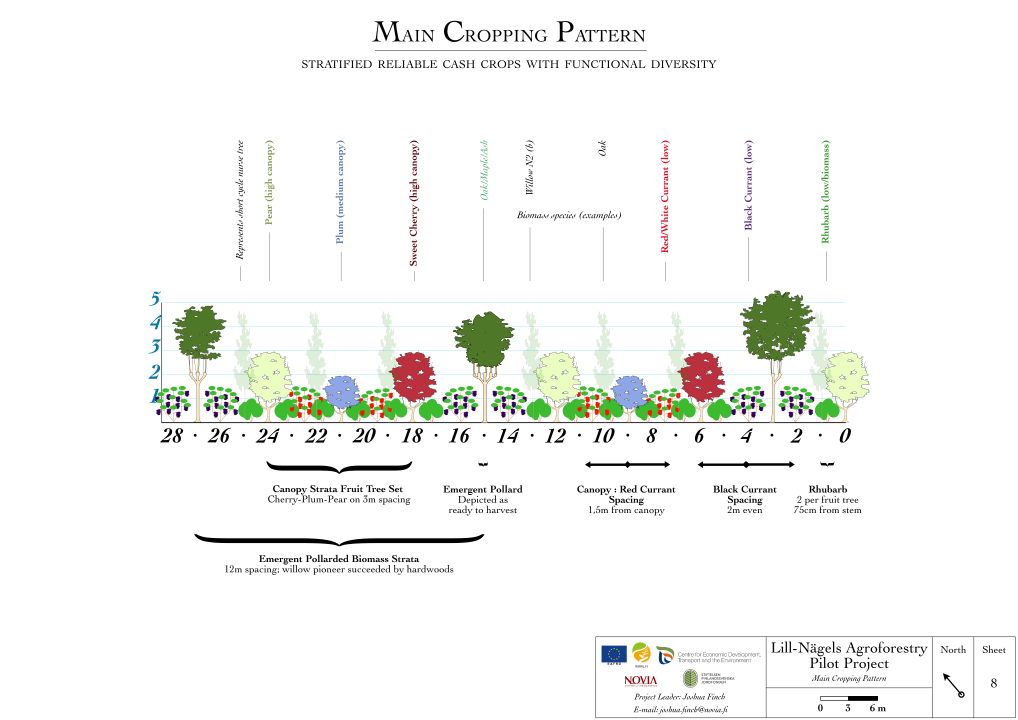
The main cropping pattern has two distinct features:
- a 10 meter wide section characterized by fruit trees in the canopy
- and a 4 meter wide section made obvious by the long-term emergent pollards in between.
I've called the fruit tree sections "sets" and the spaces with pollards are called "gaps."
Canopy Strata Fruit Tree Sets
The fruit tree sets are typically planted as displayed above: a sweet cherry leads the three fruit trees, making use of that position to meet its strong light requirements. A plum is planted 3 meters "behind" it where it will also have close to full sun, but if the cherry casts some shade, the plum can handle this and still produce. As the plums will be kept smaller- perhaps not as small as 2 meters like in the images above, but around there, it will cast less shade to the next canopy tree which is a pear. Pears also have high sun requirements and thus will grow a bit larger. The fruit trees are planted 3 meters apart because they are mostly on semidwarfing stock and will be pruned and/or trained to be rather compact, but still free-standing, trees. At about 3 meters tall at most, these pedestrian style trainings also need to be balanced laterally, hence the tight spacing.
Each fruit tree has a willow planted behind it, depicted in the image above as translucent, short cycle nurse trees. Willows grow very quickly and will serve as early succession emergents, creating structural diversity above the system. These will be culled out as the system progresses.
We have stratified the system below the canopy by using currants and rhubarb. Red currants and white currants have been chosen as production species between fruit trees in a set due to a slightly greater shade tolerance than black currants. These are planted 1,5 meters, or halfway, between each fruit tree. In addition, each fruit tree has a pair of rhubarb crowns associated with it, planted 75 centimeters from the stem. This is fairly close, but the rhubarb plants will be managed for continuous mulch production in addition to food.
When counting the plant families in the fruit tree sets, we arrive at 4 rather easily from the rosaceae, grossulariaceae, polygonaceae, and salicaceae families. This is important for fostering biodiversity above and below ground, in addition to the attempt at positioning the plants according to strata or niche. When we begin to add in the support species planted by seed, such as oak, maple, ash, and elm, the diversity increases again at the plant family level (4 more!) in addition to the inclusion of ectomycorrhizae, which may or may not prove to be useful additions to the soil microbiome. So far there is no scientific evidence that mycorrhizal diversity at that level improves outcomes, but we do see intermingling of endo (arbuscular) and ectomycorrhizal fungi in natural systems. Then you can include the biodiversity from the cover and cash crops grown in 75 cm beds on either side of this central line of trees- as well as the ongoing effort to plant spring ephemeral flowers- we reach planned diversity levels >10 plant families rather quickly.
Ultimately the spacing is likely to be wrong. I've spent a fair bit of time comparing how the plants are spaced in monocultures and how they could be spaced here and decided upon this. There's full recognition that, over time, we will see where these spacings break down or where they shine. However, without someone (us) actually planting a system and managing it, there will never be any data to inform the planting of stratified successional agroforestry systems in our climate. Forest garden spacings are useful, but ultimately there are management and planning differences that also preclude us from simply copying those designs. Namely, the fact that all of our species are planted in straight lines with 14 meters from one tree line to the next (12 meter alley + 1 meter in one tree line + 1 meter in the other tree line). We are not creating a closed canopy system with this kind of spacing and perhaps the amount of light coming from the sides is going to make a big impact on whether this tight spacing works or not.
Management is key to keep the whole system productive and healthy. Unlike many traditional forest garden designs, we are intentionally planting many more species- and closer together- than is usual with the idea that they will exit the system once they've performed their function. Instead of approaching the successional agroforestry design as a "hands off" initiative, these systems are about being hands on. If I find time to create the management section of this website we will try to document the evidence for the hands on approach.
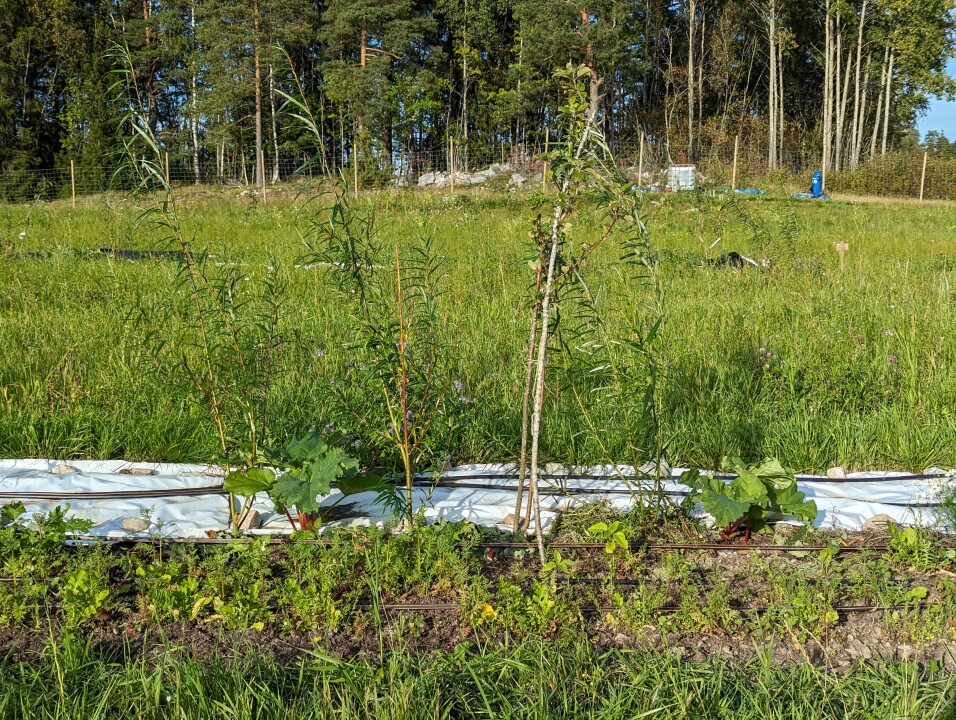
Above: 18.09.2023 in T4: older apple tree, center, with support willows already beginning to move into emergent layer despite the drought (see the dead stem to the left of the apple tree). Rhubarb plants are growing in the low strata as planned. To the left there is space where a currant bush would be planted. The foreground shows a cover crop growing after garlic was harvested.
Emergent Pollard & Black Currant Gaps
Another potential issue with this design is the over reliance upon species from the rose family (primarily cherry, plum, and pear). The deliberate introduction of other perennials with different functional traits, such as currants and rhubarb, should help create a diverse soil ecosystem where the buildup of pathogens is kept in check by the healthy soil. However, above ground, we still have a system where there are not many functional gaps between the rose family fruit trees. So between each set, I've added a gap. Depending on how you measure this gap, it is either 4 (crown to crown) or 6 meters (stem to stem). These breaks allow for more air flow between the trees and serves as small, but extant, physical barrier for insects to cross from one fruit tree to the next.
The gaps create space for black currants to harvest more sunlight. Above the currants will be a single, long term, biomass species managed as a pollard (most likely). In the image above, the pollards have been depicted in full leaf with different numbers of regrown stems indicating that each pollard can be used to produce different sized material from rods to potentially even poles. In practice the species will be in varying stages of regrowth and the character of a gap will be much more readily apparent.
T2 Crop Succession
T2: Garlic -> Rhubarb -> Currants -> Plums/Cherries -> Apples/Pears
T2 Cultivar Selection
- Canopy Fruit Trees
- Apple: Afrodita, Kandil Orlovskij
- Sweet Cherry: Sylvia, Kordia, Rosso Skanskaja, Iputj
- Pear: Vasarine Sviestine, Lada, Selija
- Plum: Renklod d'Oullins, Victoria, Opal, Renklod Zholtyj
- Peach: Inka, other died back to roostock and needs grafting
- Apricot: n/a- from seed
- Low Currants
- Blanka (White)
- Titania (Black)
- Rovada (Red)
- Viksnes (Red)
Tree Line Three (T3) Cross Section: Main Crops on Deep Soil
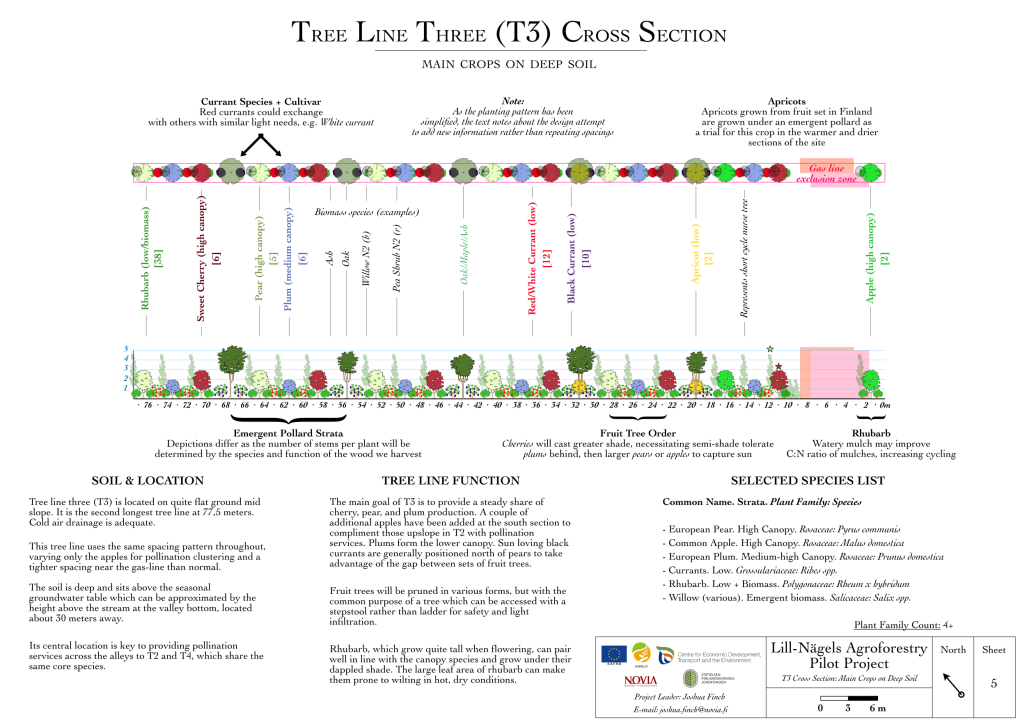
As we move down the slope we reach an area where the sand-loam soil ends and we are quite entirely planting into clay-loam.
T3 Design
See T2. The main difference is that the position of the gas line exclusion zone meant that some of the trees needed to be positioned closer to one another and the first apple does not have room for shrubs below.
T3 Crop Succession
T3: Garlic -> Rhubarb -> Currants -> Plums/Cherries -> Apples/Pears
T3 Cultivar Selection
- Canopy Fruit Trees
- Apple: Kandil Orlovskij, Roberts
- Sweet Cherry: Sylvia, Kordia, Rosso Skanskaja, Iputj
- Pear: Vasarine Sviestine, Lada, Belorusskaja Pozdnjaja
- Plum: Renklod d'Oullins, Victoria, Opal, Eurasia 21
- Apricot: n/a- from seed
- Low Currants
- Blanka (White)
- Titania (Black)
- Rovada (Red)
- Viksnes (Red)
Tree Line Four (T4) Cross Section: Main Crops on Deep, Moist Soil
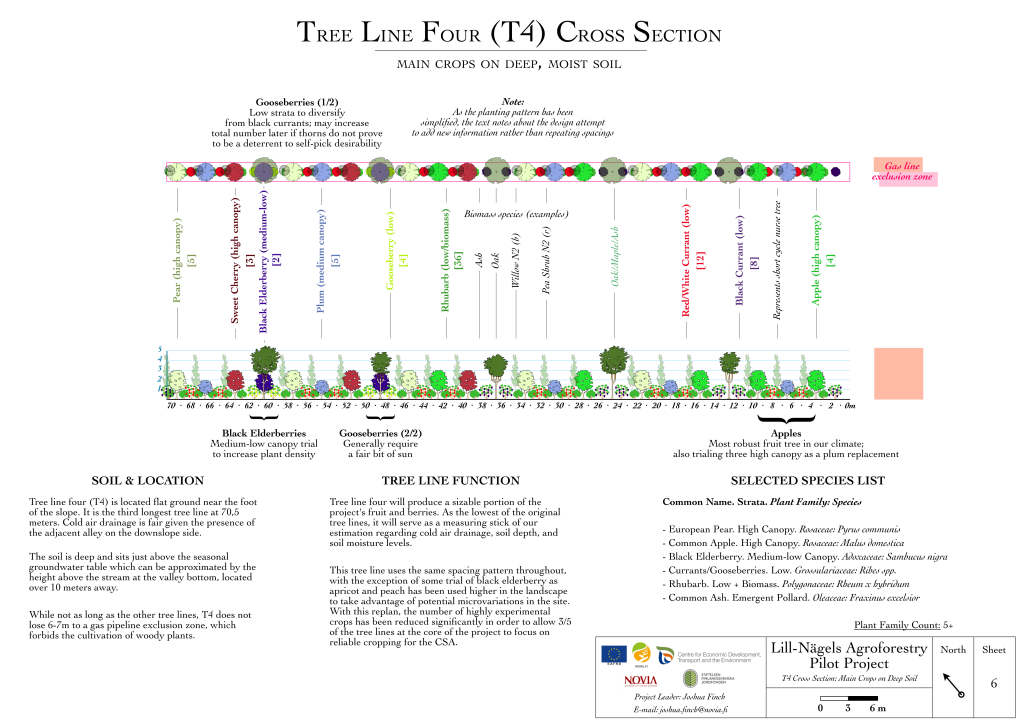
The fourth tree line sits the lowest in elevation, is almost completely flat, and has deep soil throughout. It is only about 20 meters from the stream and in terms of elevation, is only a couple of meters above where we have perennial flow. This has an impact on soil moisture as well as cold air drainage: it would be wise to consider this part of the field as the valley bottom.
T4 Design
See T2. After we shortened the tree line to make room for the perimeter tree lines, the gas line exclusion zone no longer affects the system. So this is the first one where we do not have a ±6 m wide gap with no woody species allowed. The pattern changes a little bit from the other two in that we have more apples, including an apple swapped for a plum's position, and the introduction of a couple black elderberries and gooseberries at the far end. Additionally white currants feature heavy here.
This tree line may actually be a little bit longer and accommodating of one more canopy fruit tree, depending on checking how the tractor and combine moves around the north end.
T4 Crop Succession
Garlic -> Rhubarb -> Currants/Gooseberries/Black Elderberry -> Plum/Cherry -> Apple/Pear
T4 Cultivar Selection
- Canopy Fruit Trees
- Apple: Ametis, Dace, Roberts, Ivuska
- Sweet Cherry: Rosso Skanskaja, Iputj
- Pear: Vasarine Sviestine, Lada, Belorusskaja Pozdnjaja, Tihij don
- Plum: Renklod d'Oullins, Common Yellow, Yellow Apricot, Opal
- Medium
- Black elderberry
- Low Currants/Gooseberry
- Blanka (White)
- Titania (Black)
- Rovada (Red)
- Viksnes (Red)
- Gooseberries- from cuttings of unknown "found" heritage variety
Tree Line Five (T5): Process Based Riparian Buffer
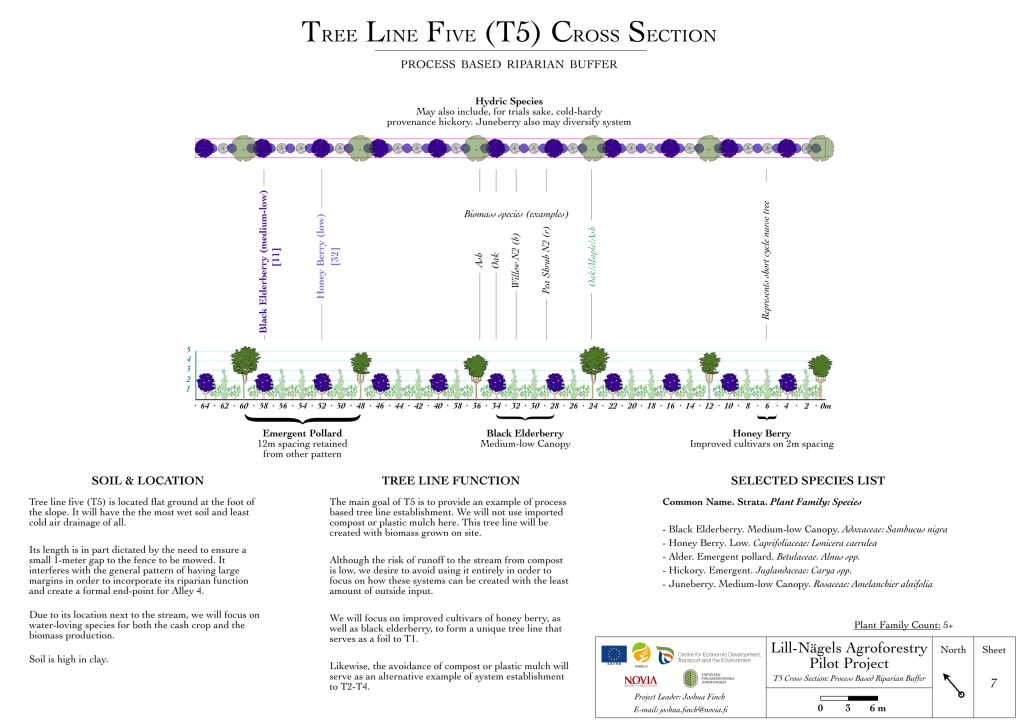
The last tree line has not been planned in great detail as of yet. There is just enough room to have a regularly sized tree bed here and it would run for 65 meters. It comes very close to the fence line for most of that stretch and could pose some management challenges.
Despite the drawbacks of a tight fit, adding another tree line would expand the total number of trees in the system by quite a bit and only remove space from the margin. With strip cropping in A4, we can reach T5 by tractor easily when a cover is planted in strips 1 and 2. Otherwise there is just enough space between the tree line and the fence to squeeze in with a garden cart or wheelbarrow and approach T5 from M2.
Species selection would focus on hydric species like willow, alder, black elderberry, and honey berry. I can see this system being a lot more dense and high in biomass plants to provide a thicket-like hedge for birds to nest.
The key difference between how we would create this tree line and the others is that, since I did not intend to have a fifth tree line in the first place, we do not have any compost to apply here. I would like to utilize occultation and deep mulching to shift the soil in this tree bed. We will create this from the cover crops grown in the alleys and/or margins, so the only outside inputs are for plants, fungi, bacteria and other inoculants.
Following the changes in the soil would require adding another management zone to our sampling schedule.
Perimeter Tree Line Designs
These are still in the works. We may decide against planting P1 and P2 as a wider margin may ultimately be necessary for the combine to work the site.
5. Irrigation
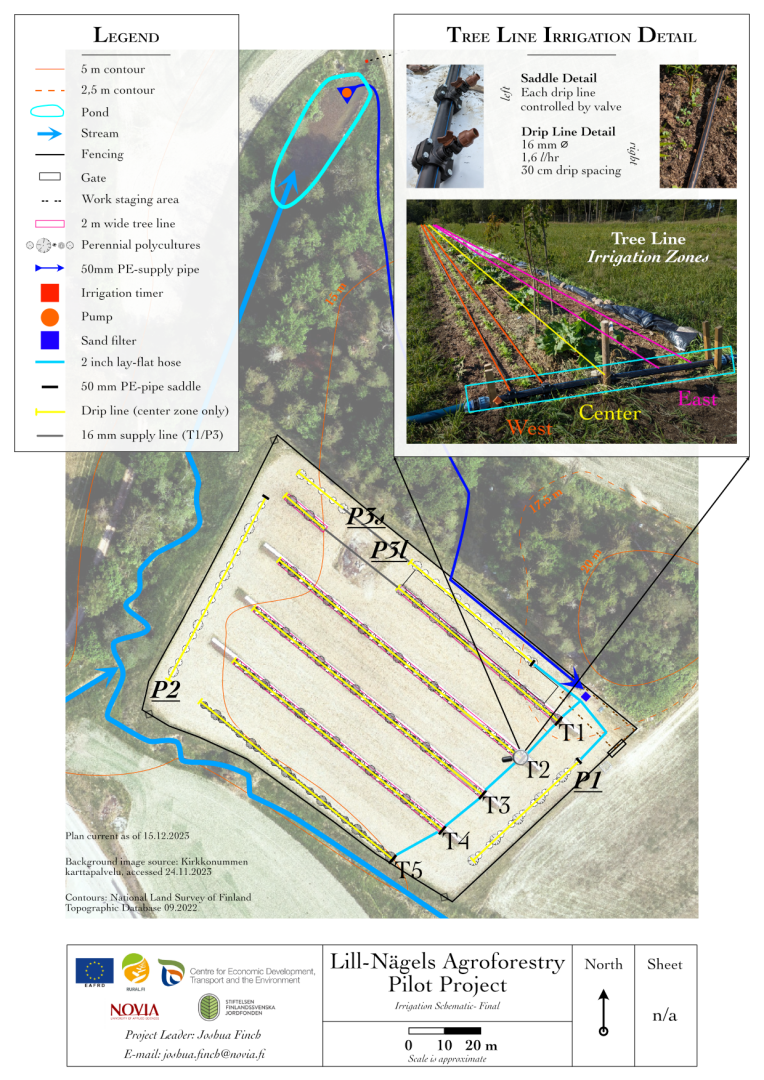
Note- there is a mistake on the plan view that shows a gray rectangle just below P3l, which looks like a "16 mm supply line." The supply lines only connect the long and short tree lines together over the shallow and exposed rock surface.
Irrigation is a very important aspect of the project. The site was chosen in part because of its proximity to a preexisting erosion control pond, located about 60 meters directly north of the northernmost corner of the field. The pond is supplied by water moving through about 35 hectares (see the Site Analysis section for information) of fields and forests and has not reduced in level significantly even during the two droughts of 2022 and 2023.
While there are plenty of dry-land orchards, we decided early on that our system would use irrigation. This is in part because the soil is not quite healthy enough to support planting fruit trees without supplemental irrigation. With soil organic matter levels less than 4%, planting trees in a drought-prone site without the ability to bring them water could be a costly mistake. In addition, we want to also produce early succession cash crops, like garlic, to reduce the time for the system to begin returning on the investment.
Garlic can use up to 25 liters of water each week per linear meter. This is well beyond the capacity of our soil to provide at this time.
Initially, we wanted to have a hybrid system: drip irrigation for the central perennial plants and a micro-emitter based system for ensuring very even surface irrigation of the 75 cm beds on either side. This system would allow for direct sown cover crops (or other species) to receive proper water to trigger germination. However, the amount of energy required for this system was cost prohibitive as it required three-phase cables run the entire length to the pond.
Upon considering the most powerful pump that could be run with single-phase electrical cables, we decided to use drip irrigation only. In the graphic above, you can see the detail where the tree lines are supplied with 5 drip lines divided into 3 zones. Each drip line has an on/off valve (manual) which allows us to direct water where it is needed.
The water in the pond has suitable levels of nutrients and pH for irrigating vegetables and perennials. However, the pond water in the autumn returned higher than acceptable levels of key bacterial groups. This means the water is not usable for vegetables (the garlic and rhubarb), but could still be applied to tree crops. We are planning to test the water again in the spring when the bacterial levels could be different. In addition, other options are being looked into that could potentially restore the irrigation water to standards.
6. Conclusion
The site design pulls together a lot of different techniques and ideas from across the agroecological and regenerative agriculture landscape. We have paid attention to the change in site characteristics and tried to imagine the system from many points of view. While details have changed over time, the overall effort to incorporate cash crops by stratification while allowing ample light infiltration into the alleys will remain the same.
If you would like to immediately follow to implementation, you can click this link to take you to the Timeline page. For more current updates you can follow the project on social media:
Instagram: @lillnagels_agroforestry
Facebook: Lill-Nägels Agroforestry Pilot Project
YouTube: @Lill-NagelsAgroforestry
